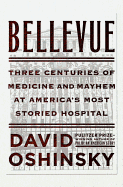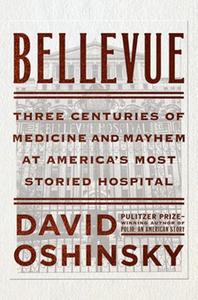
 Bellevue is one of the oldest and most famous names in United States hospitals, known for housing violent criminals and mental health patients, the homeless and sufferers of rare and exotic diseases. The incredible, multi-layered history told by David Oshinsky in Bellevue: Three Centuries of Medicine and Mayhem at America's Most Storied Hospital covers medical and general history both national and global. This thorough narrative is wide-ranging and endlessly gripping.
Bellevue is one of the oldest and most famous names in United States hospitals, known for housing violent criminals and mental health patients, the homeless and sufferers of rare and exotic diseases. The incredible, multi-layered history told by David Oshinsky in Bellevue: Three Centuries of Medicine and Mayhem at America's Most Storied Hospital covers medical and general history both national and global. This thorough narrative is wide-ranging and endlessly gripping. The institution began in 1736 as an almshouse, where the indigent were housed and given rudimentary medical care. From these earliest days, "Bel-Vue" had a reputation for dealing with society's unwanted. And as Oshinsky shows, in its many incarnations, this reputation is intact. The flipside is that this public hospital has always attracted service-minded professionals pursuing innovation. Before modern considerations of medical ethics, this often meant experimenting on Bellevue's impoverished patients and their diverse range of ailments: in exchange for charity medical aid, the thinking went, they offered themselves for clinical trials--as painful and medieval as they could be at times. Nevertheless, the hospital became central over the years in battling the yellow fever epidemic of the 1790s, the "Great Influenza" of the 1910s, the AIDS crisis of the 1980s, the September 11 attacks and Superstorm Sandy. Bellevue would see hospitals shift from being considered a last resort, only for those too poor to afford a private doctor's home visits, to becoming the best medical care available (the development of anesthesia, germ theory and infection control being crucial).
The hospital has enjoyed affiliations with several medical schools, among the U.S.'s earliest and best, including its continuing relationship with New York University. NYU students get training in a premier teaching hospital that still treats an enormous and diverse patient population, while Bellevue gets talented, passionate residents and interns, many of whom remain and make their careers there. The history of Bellevue reflects social struggles, as women, Jews and African Americans gradually gained access to the medical profession, and anti-immigrant vitriol was aimed in turn at Irish, Italian and Jewish populations, among others, as waves of struggling immigrants contributed to Bellevue's patient population. Bellevue successfully treated New York's sole Ebola patient in 2014. Its tenuous funding situation (mostly public, and always under attack), high standards of care and public service mission continue.
Bellevue's beauty and staggering scope lies in these historic, social and interdisciplinary connections. William Burroughs, Sylvia Plath, Charlie Mingus and Lead Belly passed through Bellevue's history; its physicians have traveled the world and played roles in the scientific advances that have shaped modern medicine. Bellevue hosted the invention of forensic medicine, and major developments in medical photography, child psychiatry and AIDS treatments. Oshinsky (Pulitzer Prize-winner for Polio: An American Story) generally adheres to an impersonal, journalistic style, but his moving portrayal can't hide his admiration for this longstanding institution. Bellevue is that rare, page-turning history: engaging, smart, clearly written and of broad general interest. --Julia Jenkins, librarian and blogger at pagesofjulia
Shelf Talker: This fascinating history of New York's famous public hospital provides a microcosm of national and worldwide medical history.

